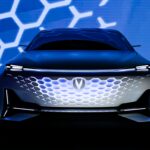In the deep space adventure world of Star Trek, high-tech ships are propelled forward with incredible efficiency by utilizing something known as an “impulse drive”. This drive allows them to travel at speeds approaching — but never quite reaching — the speed of light. Intrepid crew members travel between planets in minutes. Sometimes they even go back and forth between different worlds in the span of a single day.
This is unimaginable for us. Getting to our neighboring world of Mars will take at least 7 months with our best technology. A mission to the red planet and back would span over a year at minimum. A far more ambitious visit to our nearest star system, needless to say, is out of the question for humanity today. At 4.37 lightyears away the neighboring Alpha Centauri system would take 16,000 years to reach with conventional rockets.
Star Trek’s impulse drive is a fusion rocket that works alongside a driver assembly and a special thrust nozzle. As the fusion reaction generates high-energy plasma, it is directed out of the thrust nozzle as exhaust. The plasma may be passed through driver coils which make it even more efficient and provide greater propulsion. There are, of course, many details about the impulse drive that remain highly fictional and cannot translate into real world engineering. The single most important characteristic of the impulse drive is that it can move a spaceship forward at sub-luminal speeds, allowing crew members to travel between planets and star systems well within their lifetimes.
And this is exactly what two physicists at California State University are now attempting to build.

Their version of the impulse drive is called the MEGA drive — or the Mach Effect Gravity Assist drive. The most surprising feature of the drive is that its goal is to move at about 40% the speed of light or higher, all without using propellant. Propellants are mixtures of fuel and oxidizers. Every spacecraft we have ever engineered relies on propellants to travel through the universe. To say that a spacecraft can travel without propellant is like saying a car will travel without gasoline. The answer, unsurprisingly, is electricity.
The MEGA drive is founded in something known as Mach’s principle. As it’s interpreted for the MEGA drive, Mach’s principle states that distant objects in the universe are partly responsible for the inertia of objects around us. Inertia is an object’s tendency to resist any kind of change in its movement — that is, an object in motion wants to stay in motion and an object at rest wants to stay at rest unless another force acts upon it. Mach’s principle was originally meant to be a part of Einstein’s theory of relativity since Einstein himself supported the idea, but other researchers later labored to dismiss Mach’s principle through mathematics. It remains a controversial idea to this day, which is precisely what makes the results from the MEGA drive so impressive.
Not only have they been improving steadily and significantly over the years, but there were never supposed to be any positive results in the first place according to most scientists’ interpretation of Mach’s principle. The two physicists behind the MEGA drive — Jim Woodward and Hal Fearn — have been able to increase the force produced by their drive 1,000 fold in just 1 year alone.
So how do Mach’s principle and brilliant engineering come together to produce the MEGA drive?

The drive uses electricity instead of propellant. Solar panels or nuclear reactors could generate electrical currents which would get sent through a stack of piezoelectric crystals. Piezoelectric crystals are found in everything from cellphones to printers to speakers. When an electric current passes through them, the crystals vibrate, expand, and contract. The way the physicists have set it up makes it so that the vibrations occur mainly in one direction, causing the spacecraft to move forward. This series of expansion and contraction produces a kind of wriggling or oscillation that will slowly but increasingly move the spacecraft forward. While the spacecraft will start off moving slowly through space, after a few decades it will have gained enough momentum from those small oscillations to travel at speeds near those of light.
The MEGA drive’s secret, therefor, is not a grand and sudden acceleration from the start, but a sustained acceleration over time.

Forward movement from their prototypes was extremely small in the beginning. Too small to see with the naked eye. After reconfiguration, years of work, and 2 separate grants from NASA, the team’s prototype can now produce visible thrust. It went from producing just 5 micronewtons of thrust to producing over 100. This is not a very large amount but it’s enough to show that there may be something promising to these devices. A spacecraft using this technology wouldn’t rely on just one MEGA drive but would instead be propelled forward by an array of hundreds or thousands of them. To scale these devices you don’t make them bigger, you simply make more of them.
NASA is now funding independent research of the MEGA drive. Testing at the Naval Research Laboratory and at the Hathaway Research Company in Canada will reveal if the team’s results can be replicated by other researchers. If there are positive results from testing then the next steps would be to send the devices into space and, in the future, to accelerate a probe. According to Woodward and Fearn — the original scientists behind the MEGA drive — they are close to having a space-ready device for testing.
Many scientists are expecting the MEGA drive to fail. Some have been looking for decades for a way to disprove the team’s interpretation of Mach’s principle and the apparent results created by their device. No one has so far been able to discredit the team’s work after decades of research, though it is important to note that it would be difficult to either prove or disprove something this exotic.
Still, there is no downside to testing even the most unconventional ideas. If it fails we will have learned from the experience and reinforced our scientific perspectives. Yet if it succeeds there is a universe to be gained. Not only will our perspective have been drastically changed, we will have found the technology needed to make mankind an interstellar species.





























